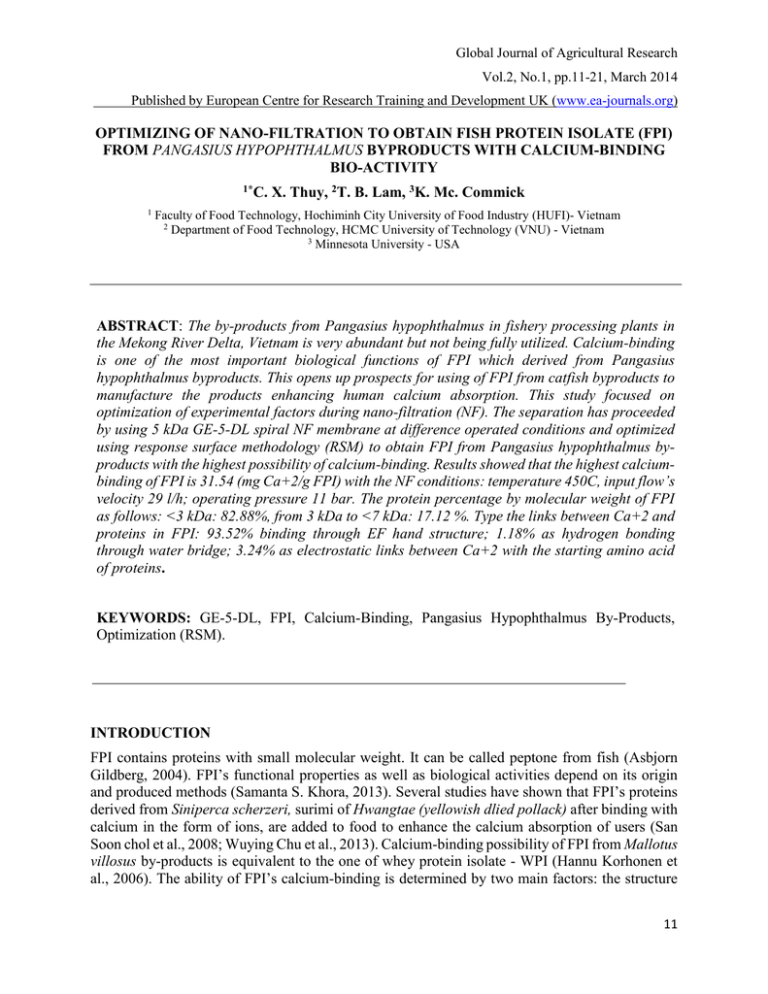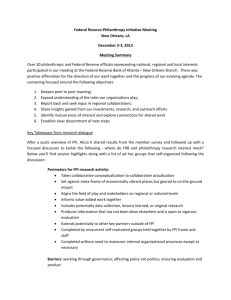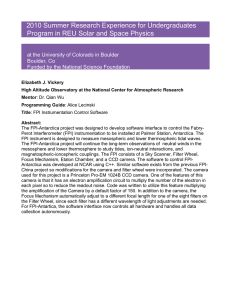NGHIÊN CỨU THỦY PHÂN PROTEIN TỪ PHỤ PHẨM
advertisement

Global Journal of Agricultural Research Vol.2, No.1, pp.11-21, March 2014 Published by European Centre for Research Training and Development UK (www.ea-journals.org) OPTIMIZING OF NANO-FILTRATION TO OBTAIN FISH PROTEIN ISOLATE (FPI) FROM PANGASIUS HYPOPHTHALMUS BYPRODUCTS WITH CALCIUM-BINDING BIO-ACTIVITY 1*C. 1 X. Thuy, 2T. B. Lam, 3K. Mc. Commick Faculty of Food Technology, Hochiminh City University of Food Industry (HUFI)- Vietnam 2 Department of Food Technology, HCMC University of Technology (VNU) - Vietnam 3 Minnesota University - USA ABSTRACT: The by-products from Pangasius hypophthalmus in fishery processing plants in the Mekong River Delta, Vietnam is very abundant but not being fully utilized. Calcium-binding is one of the most important biological functions of FPI which derived from Pangasius hypophthalmus byproducts. This opens up prospects for using of FPI from catfish byproducts to manufacture the products enhancing human calcium absorption. This study focused on optimization of experimental factors during nano-filtration (NF). The separation has proceeded by using 5 kDa GE-5-DL spiral NF membrane at difference operated conditions and optimized using response surface methodology (RSM) to obtain FPI from Pangasius hypophthalmus byproducts with the highest possibility of calcium-binding. Results showed that the highest calciumbinding of FPI is 31.54 (mg Ca+2/g FPI) with the NF conditions: temperature 450C, input flow’s velocity 29 l/h; operating pressure 11 bar. The protein percentage by molecular weight of FPI as follows: <3 kDa: 82.88%, from 3 kDa to <7 kDa: 17.12 %. Type the links between Ca+2 and proteins in FPI: 93.52% binding through EF hand structure; 1.18% as hydrogen bonding through water bridge; 3.24% as electrostatic links between Ca+2 with the starting amino acid of proteins. KEYWORDS: GE-5-DL, FPI, Calcium-Binding, Pangasius Hypophthalmus By-Products, Optimization (RSM). INTRODUCTION FPI contains proteins with small molecular weight. It can be called peptone from fish (Asbjorn Gildberg, 2004). FPI’s functional properties as well as biological activities depend on its origin and produced methods (Samanta S. Khora, 2013). Several studies have shown that FPI’s proteins derived from Siniperca scherzeri, surimi of Hwangtae (yellowish dlied pollack) after binding with calcium in the form of ions, are added to food to enhance the calcium absorption of users (San Soon chol et al., 2008; Wuying Chu et al., 2013). Calcium-binding possibility of FPI from Mallotus villosus by-products is equivalent to the one of whey protein isolate - WPI (Hannu Korhonen et al., 2006). The ability of FPI’s calcium-binding is determined by two main factors: the structure 11 Global Journal of Agricultural Research Vol.2, No.1, pp.11-21, March 2014 Published by European Centre for Research Training and Development UK (www.ea-journals.org) of proteins (the number, composition, sequencing arrangement of amino acids) and the interaction among the proteins in FPI (David M. Balshaw et al., 2001; Rong Liu et al., 2011). FPI’s peptides with a length of about 7 to 30 amino acids would have the best calcium-binding ability commonly (Laurent Picot et al., 2010; Hoa M.X., 2012). The Proteins and interaction among themselves could form EF hand structure. At EF hand structural position, calcium ions can be binded to proteins. The Ca+2 ions have been binded to proteins by ionic bonds, static links, or hydrogen bonds through the intermediate bridge of water etc… (M. Susan Cates et al., 2002; Tai M.V., 2013; Ruiyan Nie et al., 2014) Currently, the Pangasius hypophthalmus by-products from fishery processing plants in the Mekong River Delta, Vietnam is enormous (over 1 million tons/year) (VASEP, 2014). These byproducts have been mainly used as animal feed (Hoa M.X., 2013). The study how to turn the Pangasius hypophthalmus by-products to value-added products, such as FPI with high calciumbinding ability will bring significant economic efficiency for manufacturers and farmers. METHODOLOGY METERIAL Hydrolysis solution and FPI Hydrolyzing the Pangasius hypophthalmus by-products by protease (Alcalaze 2.4L) at optimum conditions (pH: 7.0; Enzyme/Substrate ratio (E/S): 0.15 % w/v ; hydrolysis temperature: 550C; hydrolysis time: 120 minutes). Hydrolyzed solution was then cooled to 40C for a preliminary defatting, vacuum filtered through non-ash paper and then centrifuged to de-fat at the speed of 15,000 rpm for 20 minutes. The solution obtained after centrifugation was brought to filter by NF membrane. The permeat was freeze-dried to get FPI powder. Determination of molecular weight of the proteins in FPI were by high pressure liquid chromatography (HPLC) NF membrane Using 5 kDa GE-5-DL spriral membrane (imported from GE Osmonics, USA). Total filtering area is 0.325 m2; maximum operating temperature is 500C; size (diameter x length) is 30.32x457.2 cm, maximum input flow is 6.53 l/min; maximum operating pressure is 41 bar. MF membrane (for preliminary filtering) Using HP3500 membranes (imported from Stirlitech, USA) Total surface area is 0.1556 m2, maximum operating temperature is 500C. Protease and chemicals Enzymes Alcalase 2.4L were purchased from EAC Co., Ltd. (sole-exclusive agent for Novozyme in Ho Chi Minh city, Vietnam). All chemicals reagents used for the experiments were in analytical grade 12 Global Journal of Agricultural Research Vol.2, No.1, pp.11-21, March 2014 Published by European Centre for Research Training and Development UK (www.ea-journals.org) METHODS Arrangement of membrane systems Membrane schematics: Where, (1) input tank, (2) stirrer, (3) controlled-valve, (4) microfiltration (MF) membrane (preliminary filter), (5) high-pressure pump; (6) nanofiltration (NF) membrane; (7) the instrument for adjusting the input solution temperature. Membrane operation Input flow was heated to proper temperature by adjusting instrument (7), preliminarily filtered by MF membrane (4), then solution will be pumped to the NF membrane (6) by high-pressure pump (5). The retentate was refluxed 10 times without diafiltration technology. The permeat (including proteins with molecular weight are smaller than 5 kDa) will be freeze-dried for collecting FPI powder. FPI powder was used for studying the calcium-binding ability as well as protein’s molecular weight. Determination of FPI’s calcium-binding possibility Calcium-binding possibility of FPI is determined by the method of Flame Atomic Absorption Spectrophotometric (FAAS). For binding Ca+2 ions to proteins in FPI 1g FPI powder was dissolved in 1 liter of sodium phosphate buffer solution (pH = 7.8); added 1.11 g CaCl2 (20mμ) to FPI solution; adjusted the temperature to about 20 - 220C; stirred for 30 minutes at speed of 100 rpm; preliminarily centrifuged at 6000-7000 rpm, adjust pH = 7 with bicarbonate buffer solution; super-speed re-centrifuged at 26,000 rpm. Calculation the calcium-biding possibility of FPI (mg Ca+2/g FPI) Vaporizing and atomization samples by gas flame. The gas clouds will absorb the monochromator radiation beam. Using the spectrometer for collecting the entire separation spectrum beams and select a calcium spectral absorption line in order to measure its intensity. In a certain limit of concentration (C) of substances to be determined. The value of this intensity depends linearly on the concentration (C) according to the following equation: A = a.C; Asb = lg = ep.l.c I0/It Where: A is the intensity of the spectral absorption; a is experimental constant; C is concentration of substances to be determined (mg/g) Testing the links between Ca+2 and proteins in FPI - After Ca+2 associated with proteins in FPI (section 2.2.2.), to ensure that Ca+2 were binded to proteins by ionic bonds, static links, or hydrogen bonds through the intermediate bridge of water 13 Global Journal of Agricultural Research Vol.2, No.1, pp.11-21, March 2014 Published by European Centre for Research Training and Development UK (www.ea-journals.org) etc… (Not a mechanical bond). The solution obtained after ultracentrifugation at 26000 rpm will added 25ml LYSIS buffer solution (Consists of 50 mμ Tris-H3PO4; 2 mμ EDTA, 1 mμ phenyl methyl sulfonyl fluoride (PMSF), 1microgam leupeptin). - The solution was put into a magnetic field; cooled at 40C for 5 minutes to ensure the complete removal of CaCl2 that were stick or not binded to a protein in FPI; Adjusted the pH to 7.5; brought the solution to monochromatic radiation environment. The spectral lines of calcium ions will be magnified 20000 times to know the density of calcium-binding to the FPI’s proteins. Optimization of NF operation to FPI’s calcium-binding ability Experimental planning: Response Surface Methodology (RSM) with 2 fold rotation plan centered (star distance α = 1.682) is applied to optimize the conditions of NF operation. In particular, preliminary experimental has previously been selected as the basis for experimental optimization design. The parameters include: temperature, velocity and pressure of input flow. RESULTS AND DISCUSSION Optimization of NF operation Before optimizing, we conducted preliminary experiments to identify the influence of each individual factor (temperature, velocity and pressure of input flow) to FPI’s calcium-binding ability. The results of preliminary experiments were used as the basis for determining the simultaneously impact by all of three above factors to FPI’s calcium-binding ability When designing the optimization modal, the temperature of input flow (X 1, 0C), velocity of input flow (X2, litter/h), and pressure of input flow (X3, bar) were experimented simultaneously for 2 purposes: (1) to building the regression equation that describe the relationship among the NF operation’s factors that influence to the FPI’s calcium-binding ability from Pangasius hypophthalmus by-products. (2) Finding out the NF operation’s conditions in order to achieve the maximum FPI’s calcium-binding ability. The experiment levels of independent factors in optimization as follows (Table 1): Table 1. Levels of independent factors in optimization Levels of factors Factors -α -1 0 +1 +α 0 Temperature of input flow (X1, C) 37 40 45 50 53 Velocity of input flow (X2 , l/h) 17 20 25 30 33 Pressure of input flow (X3, bar) 7 8 10 12 13 The coded levels of variables: above level (+1); database level (0); below level (-1); α = 1,682 The experimental number were calculated as follows: N = 2k + 2k + n0 = 23 + 2.3+6 = 20 (k: number of experimental factors (k = 3), n0: number of experiments in center or mind (n0 = 6). Experimental matrix shows the simultaneously of the factors is presented in Table 2. 14 Global Journal of Agricultural Research Vol.2, No.1, pp.11-21, March 2014 Published by European Centre for Research Training and Development UK (www.ea-journals.org) No Coded levels of variables x1 1 2 3 4 5 6 7 8 9 10 -1 1 -1 1 -1 1 -1 1 -1.682 1.682 x2 x3 Table 2. Experimental matrix Observed Real variables calcium-binding ability (mg/g X1 X2 X3 FPI) 40 20 8 22.61 50 20 8 25.22 40 30 8 25.87 50 30 8 28.81 40 20 12 25.22 50 20 12 25.87 40 30 12 29.13 50 30 12 28.48 36.59 25 10 24.57 53.41 25 10 25.87 Expected calcium-binding ability (mg/g FPI) 22.59 25.35 26.15 28.43 25.77 25.76 29.17 28.67 24.15 26.05 -1 -1 -1 -1 1 -1 1 -1 -1 1 -1 1 1 1 1 1 0 0 0 0 11 0 0 45 16.59 10 25.22 24.98 1.682 12 0 1.682 0 45 33.41 10 30.44 30.44 13 0 0 -1.682 45 25 6.64 25.87 25.94 14 0 0 1.682 45 25 13.37 29.13 28.82 15 0 0 0 45 25 10 30.96 30.80 16 0 0 0 45 25 10 31.09 30.80 17 0 0 0 45 25 10 30.76 30.80 18 0 0 0 45 25 10 30.41 30.80 19 0 0 0 45 25 10 30.44 30.80 20 0 0 0 45 25 10 31.09 30.80 Regression equation is a second-order polynomial: 𝑌 = 𝛽0 + ∑3𝑖=1 𝛽𝑖 𝑋𝑖 + ∑3𝑖=1 𝛽𝑖𝑖 𝑋𝑖2 + ∑3𝑖=1 ∑3𝑗=𝑖+1 𝛽𝑖𝑗 𝑋𝑖 𝑋𝑗 Where, Y is the dependent variable (calcium-binding ability in real value); Xi and Xj are the levels of the independent variable (experimental factor) which represent the influence of X1, X2, X3 on the response factor (calcium-binding ability); β0 is constant; βi, βii, βij are the coefficients of the regression equation. To build the mathematical description as a regression equation, the coefficients of the equation must be determined. Its coefficients have the following values: b0 = 30.80 b1 = 0.57 b2 = 1.62 b3= 0.85 b11 = -2.01 b22 = -1.09 b33 = -1.21 b12 = -0.12 b13 = -0.69 b23 = 0.04 Two of coefficients: b12 (P=0.76459 > 0.05) and b23 (P=0.386967 > 0.05) have no statistical significance. Thus, these coefficients (b12 and b23) are removed from the regression equation. The regression equation takes the following form: Y = 30.80+ 0.57 X1 + 1.62 X2 + 0.85 X3 – 2.01 X12 – 1.21 X22 + 0.47 X32 – 0.69X1X3 Testing the compatibility of the regression equation and experimental results shows that three experimental factors (X1, X2, X3) have a strong influence (P<0.05) on the calcium-binding ability of FPI from Pangasius hypophthalmus by-products during NF operation. The compatibility of the 15 Global Journal of Agricultural Research Vol.2, No.1, pp.11-21, March 2014 Published by European Centre for Research Training and Development UK (www.ea-journals.org) regression equation (Lack of fit) is checked with the Modde 5.0. After checking, the "Lack of fit" is not statistically significant (Lack of fit has P = 0.23, P> 0.05). Thus the regression equation has high compatibility with experiments (Kun-Nan Chen, 2008) Table 3. Testing results the compatibility of the regression equation Degree of Sum of Mean P Source Freedom Squares Squares F value value (DF) (SS) (MS) Regression 9 136.91 15.2123 105.833 0.000 significant Residual 10 1.43738 0.143738 Lack of Fit 5 0.960699 0.19214 2.01539 0.23 insignificant Pure Error 5 0.476682 0.0953365 Total Corrected 19 138.348 7.28146 The influence of the experimental factors on the calcium-binding ability of FPI from Pangasius hypophthalmus by-products are shown on the contour and response surface in Figure 1 Overall, the calcium-binding ability of FPI increased gradually along with the rising of experimental factors to a limited value during NF operation. However, then the calcium-binding ability was stability and it is tended to decrease when the values of factors exceeded the limit value. Figure 1-B shows the effects of pair of elements (X1: temperature of input flow and X3: pressure of input flow) on FPI’s calcium-binding ability. Results indicate that calcium-binding ability rises up about 25% plus, along with the increasing of the temperature (to 450C) and pressure (to 11 bar). However, the calcium-binding ability tended to reach a stable value and then reduced lightly when NF operation was carried out in condition of higher temperature and pressure. Figure 1-A showed the influence of the remaining pairs of elements: temperature (X1) and input flow’s velocity (X2) to calcium-binding ability of FPI. At temperatures between 400C and 450C, the calcium-binding ability increased nearly 19% (from 25.38 mg Ca+2/g FPI to 31.38 mg Ca+2/g FPI). However, when input flow’s velocity continued to rise, calcium-binding ability decreased lightly. The same rule is observed (in Figure 1-C) when considering simultaneously the impact of X1 and X2 (velocity and pressure of input flow respectively). This is explained as follows: as the increasing of temperature, the movement speed of the proteins in solution also increased. Pressure and velocity of input increased making the rising of both flux through the membrane and the separation level of proteins in FPI (Laurent Vandanjon et al., 2007; Anusha Geethangani Perera Samaranayaka, 2010). So the number of proteins with small molecular weight in permeat would be increased. The group of small molecular weight proteins (1-3 kDa) has the highest calcium-binding ability (Hoa M.X., 2012; P. Bourseau et al., 2009). This causes the rising of FPI’s calcium-binding possibility. However, when we increased the input flow’s velocity and pressure without application of diafiltration technology would cause the fouling and concentration. The small molecular weight proteins in permeat tended to be stable. So the FPI’s calcium-binding will hardly increase. On the other hand, prolonging NF operation time can affect the interaction of the proteins in solution (Tai M.V., 2013). This influence should decrease calciumbinding of FPI. 16 Global Journal of Agricultural Research Vol.2, No.1, pp.11-21, March 2014 Published by European Centre for Research Training and Development UK (www.ea-journals.org) Figure 1. Contour and Response Surface showing the influence of three experimental factors on the FPI’s calcium-binding ability. Optimization results show that the calcium-binding ability of FPI from Pangasius hypophthalmus by-products reaches the highest of 31,54 (mg Ca+2/g FPI) in terms of NF operation factors: temperature is 450C, velocity of input flow is 29 l/h, input flow’s pressure is 11 bar. The above optimization results are similar to previous studies have been published for calciumbinding of FPI from Sardinella aurita, zebrafish and rainbow trout. The calcium-binding ability of FPI from Silver carp is 31.09 calcium (Ca+2 mg/g FPI) with the NF operation factors: temperature of input flow 450C, pressure of input flow 12 bar, velocity of input flow 25 l/h (Tai M.V., 2013; Zhengjin Cao et al., 2003). Calcium-binding ability of FPI from Salmon’s surimi is 29.93 (mg Ca+2/g FPI) in the operating NF conditions: temperature of input flow 420C, pressure of input flow 10 bar, velocity of input flow 25 l/h (Laurent Picot et al., 2010). Our findings about Calciumbinding ability of FPI from Pangasius hypophthalmus by-products has been similar to the studying results about the calcium-binding ability of FPI that derived from Pangasiidae by-products, blue whiting surimi. This one reached 30.02 mg Ca+2/g FPI in NF operating conditions: temperature of input flow 450C, pressure of input flow 11 bar, velocity of input flow 28 l/h (Hoa M. X., 2012; P. Laurent Vandanjon et al., 2007) 17 Global Journal of Agricultural Research Vol.2, No.1, pp.11-21, March 2014 Published by European Centre for Research Training and Development UK (www.ea-journals.org) The analytical results of the molecular weight of proteins in FPI from Pangasius hypophthalmus by-products Analytical results of the molecular weight of proteins in FPI that derived from Pangasius hypophthalmus by-products in the NF operating conditions after optimization (temperature: 450C, velocity of input flow: 29 l/h, input flow’s pressure: 11 bar) to have the highest calcium-binding ability 31,54 (mg Ca+2/g FPI) are shown in table 4 and Figure 2. Table 4. The ratio distribution basing on molecular weight of proteins in FPI Molecular Ratio No weight (%) (kDa) 1 > 20 0 2 10 ÷ 20 0 3 7 ÷ 10 0 4 3 ÷ <7 17.12 Figure 2. HPLC analysis results determining the molecular 5 <3 82.88 weight distribution of proteins in FPI According to results in Table 4, when the input flow’s pressure reached 11 bar, the proteins in FPI in the molecular weight of 7 kDa or smaller than accounted for 17.12%, in which the proteins that molecular weight less than 3 kDa are dominant (82.88 %). This group of peptide plays a decisive role to calcium-binding ability of FPI. The rate of proteins in molecular weight <3 kDa accounted for approximately 60 % of the FPI’s total protein would have an important role in improving the calcium-binding ability of FPI. This result is similar to studyings of Tai M.V., 2013; Laurent Picot at al., 2010. They confirmed that calcium-binding ability of FPI obtained from Sardinella aurita or Clupea harengus or Gasdus morhua reached the highest value when quantity of protein with molecular weight from 2 kDa to 8 kDa around 70%. The links between Ca+2 and proteins in FPI from Pangasius hypophthalmus by-products Results of testing the links between Ca+2 with FPI’s proteins are shown in Table 5 and Figure 3. Table 5 shows that in condition of optimal values of factors during the NF separation, especially when velocity and pressure of input flow reached 29 l/h and 11 bar respectively, the number of small molecular weight proteins in permeat has gained the maximum value. The small molecular weight proteins (mainly from 1 to 3 kDa) play a key role in FPI’s calcium-binding ability. The small-sized proteins and interaction among themselves may create many EF hand. Each EF hand can combine with Ca+2 ions by covalent bonds, ionic bonds, hydrogen bonds through the “bridge” of water or electrostatic links. 18 Global Journal of Agricultural Research Vol.2, No.1, pp.11-21, March 2014 Published by European Centre for Research Training and Development UK (www.ea-journals.org) Table 5. Results of testing the links between Ca+2 and proteins in FPI Area Ca+2 – Binding to Comment [%] protein 93.5 Binding constants of EF-hand 2 Ca+2 Ion to Calciumeffects binding protein in high predicted density 1.18 Binding constants of Hydrogen Ca+2 Ion to Calcium- bonding via binding protein in H2O medium density 3.24 Binding constants of Peptide stated Ca+2 Ion to Calciumby no loop, binding protein in low -C-Cdensity structure 2.06 not identified Figure 3. The links between Ca+2 and FPI’s proteins At the optimal values of the NF operation, there were 93.52 % Ca+2 in solution binded to proteins via forming of EF hand structure; 1.18 % linkages between Ca+2 with the proteins were hydrogen bonds through the “bridge” of water; 3:24 % links among Ca+2 and proteins are associated by electrostatic bonds (between Ca+2 with the proteins that started by no loop amino acid and beginning – C–C – structure (such as: Leu , Met , Arg...). This result is similar to findings of Tai M.V., 2013; Ann Elizabeth Theodore, (2005); Rong Liu et al., 2011. The authors confirmed that the calcium-binding ability of FPI derived from freshwater fish Blunt Snout Bream (Megalobrama amblycephala), by-product of Sardinella aurita or surimi of some catfish, mostly formed through the structure of the EF hand (over 79 %); about 6 % Ca+2 binded to proteins via electrostatic bonds between Ca+2 and amino acids in protein’s structure . CONCLUSION FPI derived from Pangasius hypophthalmus by-products through NF operation has good calciumbinding ability. The calcium-binding ability achieves maximum value 31,54 mg Ca+2/g FPI, corresponding to the NF oparation conditions as follows: input flow’s temperature is 450C, velocity of flow input is 29 l/h, input flow’s pressure is 11 bar. Type of binding between mg Ca+2 and FPI’s proteins: 93.52% via EF hand structures; 1:18% as hydrogen bonding through the medium-bridge of water; 3.24% as electrostatic links between Ca+2 and the proteins that started by amino acid with – C–C – and no loop structure. The protein percentage by molecular weight of FPI as follows: <3 kDa: 82.88%, from 3 kDa to <7 kDa: 17.12 %. 19 Global Journal of Agricultural Research Vol.2, No.1, pp.11-21, March 2014 Published by European Centre for Research Training and Development UK (www.ea-journals.org) REFERENCES Ann Elizabeth Theodore (2005) Bioactive and functional properties of catfish protein hydrolysates and catfish protein isolates, a thesis for the degree of MSc. of science, Uni. of Florida. Anusha Geethangani Perera Samaranayaka (2010) Pacific Hake (Merluccius productus) fish protein hydrolysates with antioxidative properties, A thesis for the degree of Doctor of Philosophy in the faculty of graduate studies (Food Science), The University of British Columbia. Asbjorn Gildberg (2007) Enzymes and Bioactive Peptides from Fish Waste Related to Fish Silage, Fish Feed and Fish Sauce Production, Haworth Press. Inc 1255-1262. David M. Balshaw, Le Xu, Naohiro, Yamaguchi, Daniel A. Pasek and Gerhard (2001) Membrane transport structure function and biogenesis: Calmodulin Binding and Inhibition of Cardiac Muscle Calcium Release Channel (Ryanodine Receptor) J Biol. Chem. 276 20144-20153. Hannu Korhonen, Anne Pihlanto (2006) Review Bioactive peptides: Production and functionality, International Dairy Journal 16 945-960. Hoa M.X., Lam T.B. (2008) Optimization of enzymatic hydrolysis of viscera of Pangasiidae to obtain calcium-binding protein hydrolysate, Vietnam Journal of Agriculture and Rural development 38 124-132 Kun-Nan Chen and Ming-Ju Chen. (2008) Statistical Optimization: Response Surface Methodology. Optimization in Food Engineering, CRC Press 140-165. Laurent Picot, Rozenn Ravallec, Martine Fouchereau-Péron, Laurent Vandanjon, Pascal Jaouen, Maryse Chaplain-Derouiniot, Fabienne Guérard, Aurélie Chabeaud, Yves LeGal, Oscar Martinez Alvarez, Jean-Pascal Bergé, Jean-Marie Piot, Irineu Batista, Carla Pires, Gudjon Thorkelsson, Charles Delannoy, Greta Jakobsen, Inez Johansson, Patrick Bourseau (2010) Impact of ultrafiltration and nanofiltration of an industrial fish protein hydrolysate on its bioactive properties, Journal of the Science of Food and Agriculture 90 1819-1826. Laurent Vandanjon, Ragnar Johannsson, Maryse Derouiniot, Patrick Bourseau, Pascal Jaouen (2007) Concentration and purification of blue whiting peptide hydrolysates by membrane processes, Journal of Food Engineering 83 581–589 M. Susan Cates, Miguel L. Teodoro, and George N. Phillips, Jr. (2002) Molecular Mechanisms of Calcium and Magnesium Binding to Parvalbumin, Biophysical Journal 82 1133-1146. P. Bourseau, L. Vandanjon, P. Jaouen, M. Chaplain-Derouiniot, A. Massé, F. Guérard, A. Chabeaud, M. Fouchereau-Péron, Y. Le Gal, R. Ravallec-Plé, J.-P. Bergé, L. Picot, J.-M. Piot, I. Batista, G. Thorkelsson, C. Delannoy (2009) Fractionation of fish protein hydrolysates by ultrafiltration and nanofiltration: impact on peptidic populations, Food Chemistry 244 (Issues 1-3) 303-320. Rong Liu, Hari B. Krishnan, Wentong Xue, and Chuyi Liu (2011) Characterization of Allergens Isolated from the Freshwater Fish Blunt Snout Bream (Megalobrama amblycephala), Journal of Agricultural and Food Chemistry 59 458-463. Ruiyan Nie, Yuejiao Liu, Zunying Liu (2014) The calcium-binding activity of fish scale protein hydrolysates, Journal of Agricultural Chemistry and Environment 3 11-15. Samanta S. Khora (2013) Marine fish-derived bioactive peptides and proteins for human therapeutics, International Journal of Pharmacy and Pharmaceutical Sciences 5, Suppl 3 San Soon chol, Hyo Ku Lee, Chi Won Han, Eun Soo Seung, Chang Yeon Yu, Myong Jo Kim, Na Young Kim (2008) Physicochemical Pmperties of Isolated Peptides from Hwangtae (yellowish dlied pollack) Protein Hydrolysate, Journal of Food Science & Nutrition 13 204211. 20 Global Journal of Agricultural Research Vol.2, No.1, pp.11-21, March 2014 Published by European Centre for Research Training and Development UK (www.ea-journals.org) Tai M.V. (2013) Functional properties of Sardinella aurita protein hydrolysates and Sardinella aurita protein isolates, a thesis for the degree of PhD; Nha Trang Fishery University, Vietnam Wuying Chu, Yulong Li, Kaizhuo Wang, Dunxue Chen, Honghui Li, Xufang Liang, Jianshe Zhang (2013) Expression and functional analyses of two essential myosin light chains from the fast white muscle of the spotted mandarin fish Siniperca scherzeri, Turkish Biochemical Journal 2013 Vietnam Association of Seafood Exporters and Producers (VASEP) (2014) Forecasting of Vietnam seafood exports in 2014, Journal of Vietnam Fishery 4 121-119 Vyam Hellado (2011) HPLC Methodology in determination of protein molecular weight applied in FPI. Bioprocess Technol 6 99-122 Zhengjin Cao, Robert L. Tanguay, Debbie McKenzie, Richard E. Peterson, Judd M. Aiken (2003) Identification of a putative calcium-binding protein as a dioxin-responsive gene in zebrafish and rainbow trout; Aquatic Toxicology 63 271-282. ACKNOWLEDGEMENTS We would like to express our thanks to Prof. David Dunker, University of Minnesota, USA for his invaluable help in HPLC analysis, FAAS and testing the links between Ca+2 and proteins in FPI 21



